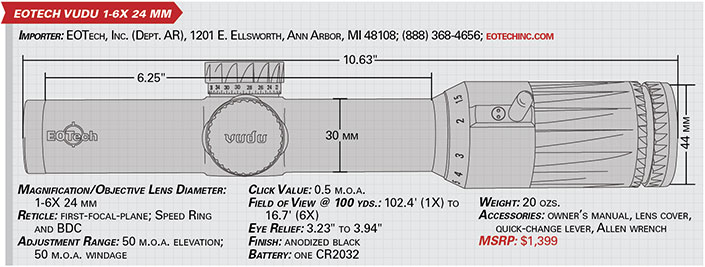
EOTech’s holographic sights are some of the most recognizable firearm optics extant thanks to widespread adoption by the military and law enforcement agencies and because of features such as the distinctive, somewhat boxy, protective housing and the proprietary Speed Ring reticle. Beyond their prevalence among real-world trigger pullers, the optics are also a staple of many “realistic” military-themed video games, and the features are often rendered very accurately. Now, EOTech hopes to parlay the accuracy and rugged construction of its 1X holographic sights into its new Vudu series, a lineup of precision-driven, variable-power riflescopes.
The Vudu line—which initially includes 1-6X 24 mm, 2.5-10X 44 mm and 3.5-18X 50 mm models—blends features favored by tactical- and precision-oriented shooters, which makes sense given EOTech’s legacy and the sights’ intended applications. Within the series, and the topic of this review, the 1-6X Vudu features oversize target-style turrets that make it easy to dial for elevation, durable anodized aluminum construction that promises a long service life and a unique first-focal-plane illuminated reticle that ties the Vudu to the rest of EOTech’s line, but also helps it stand out from the crowd.
The first thing you might notice about the 1-6X Vudu is its shape. The tubular body is standard, but the absence of an objective bell, the heavy-duty turrets and the relatively large eyepiece assembly follow a pattern that is quickly becoming the standard for mid-range scopes designed for use atop AR-style rifles. In this case, our Vudu uses a 30-mm main tube, a 24-mm objective lens and a 3.65"-long eyepiece with a 1.75" diameter. The eyepiece has a focus ring around the ocular lens that can be rotated for adjustment and, at one extreme, extends rearward 0.5". Magnification is also controlled at the eyepiece—clockwise rotation of the housing increases the power setting—and can be monitored by white numerals, etched into the top of the eyepiece housing, and their relation to a white dot engraved on the main tube. Purchase during focus or magnification adjustments is aided by blade-like serrations, or a quick-change lever (included) can be attached to one of the pre-threaded holes to facilitate faster magnification adjustments.

The Vudu has three turrets: elevation on top, windage on the right, and the illuminated reticle’s battery housing and controls on the left. Windage and elevation adjustments are made in 0.5-m.o.a. increments, values that are clearly denoted by numbers and hashmarks along the perimeters of the turrets. Changes are confirmed by very positive tactile cues, and more subtle, but still audible, “clicks.” As the turrets are rotated through their adjustment ranges, additional numbers and lines are revealed to indicate full rotations of the dials, which should help prevent users from getting lost in their adjustments. Also, once the optic is mated to a host firearm and sight-in is complete, the outer dials can be removed from the turrets and replaced so that “0” is front and center, thereby giving the user a baseline from which to make adjustments, and enabling a quick return to zero. The blade-pattern serrations are continued on the adjustment turrets, and the dials are secured by central caps, which are slotted to interface with flat-head screws, case rims, coins or the like.

The final turret houses a single CR2032 battery, which, according to the company-provided specifications, can yield about 500 hours of use at the middle of nine brightness settings. There are also three ovular, rubberized control buttons: master power at 12-o’clock; “+” at 3-o’clock, facing the shooter; and “-“ at 9-o’clock. The controls are very easy to use, even while “in the scope,” and require positive pressure to activate, which should prevent unintended adjustments.
That brings us to what is by far the most distinctive feature of the Vudu 1-6X—the reticle. The first-focal-plane (FFP) reticle is quickly becoming a favorite among American shooters, and for good reason. The primary advantage is that a FFP reticle’s subtensions—the m.o.a.- or mil-based measurements represented by stadia lines, dots or other indicators—remain consistent and true throughout the scope’s magnification range because the reticle proportionally increases in size as the image is magnified. This allows operators to use the reticle for holdovers or range estimation at any power setting, not just the highest magnification—as is common with second-focal-plane optics. EOTech took this FFP configuration a step further and designed a reticle that is extraordinarily versatile. At the 1X setting, users will see the familiar Speed Ring reflex reticle so common to EOTech’s holographic sights—a proven design for close-quarters reflex shooting. As magnification is increased, the center dot of the reticle grows and the outer ring expands to the edge of the viewing area. At the 6X setting, the outer ring is gone all together and what remains is a BDC-style (bullet drop compensating) reticle. The 1-6X Vudu has three reticle options, though the differences are only in the BDC reticle: the SR-1 is a crosshair-style reticle with stadia lines across the vertical and horizontal axes; the SR-2 and SR-3 reticles feature a modified Speed Ring with windage and elevation call-offs calibrated for the 7.62x51 mm NATO and 5.56x45 mm NATO cartridges, respectively. It’s a really slick design ideally suited for both short- and extended-range work.
Testing was happily uneventful: submersion revealed no leaks; freezing confirmed there was no internal moisture; and shooting the square was accomplished with precise, repeatable adjustments. With a suggested price of $1,399, perfect performance was expected, and the 1-6X Vudu delivered. For those planning to purchase a first-focal-plane riflescope for close- and mid-range shooting that pairs nicely with an AR-style rifle in both form and function, the 1-6X Vudu offers excellent features at a competitive price, and comes from a company with a long record of military and law enforcement service.







































